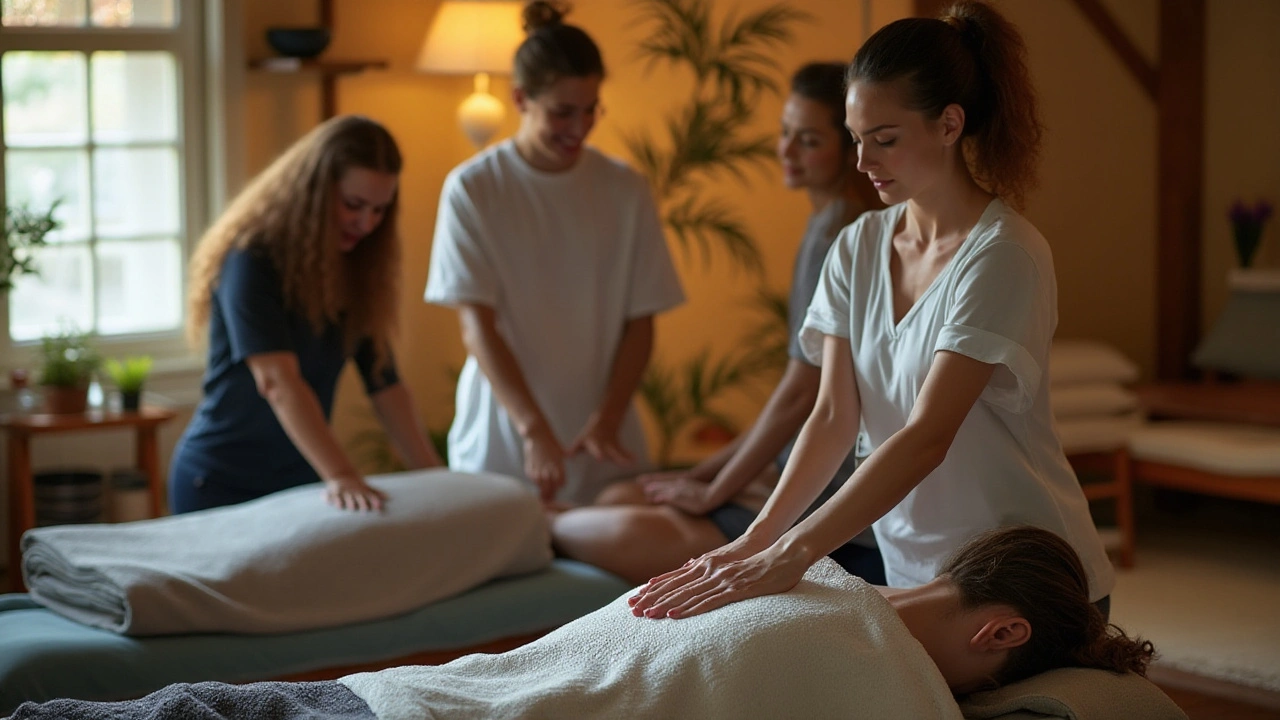Uncovering the Hidden Perks of Shiatsu Massage
 Sep, 22 2024
Sep, 22 2024
Imagine unlocking a treasure chest filled with centuries-old wisdom, healing, and relaxation techniques. That's essentially what Shiatsu massage offers. This ancient Japanese technique has withstood the test of time, delivering significant benefits to those who practice it or receive treatments.
In this article, we'll journey through the fascinating world of Shiatsu, shedding light on its history, its profound physical and mental benefits, and why it still matters today. For anyone keen on natural, holistic approaches to health, Shiatsu is a gem waiting to be discovered.
- What is Shiatsu?
- Historical Background
- Physical Benefits
- Mental and Emotional Benefits
- Shiatsu in Modern Times
- Tips to Get Started
What is Shiatsu?
Shiatsu is a type of Japanese bodywork that uses localized finger pressure in a rhythmic sequence on acupuncture meridians. In Japanese, “shi” means finger and “atsu” means pressure. Unlike other forms of massage, Shiatsu can be done through clothing and often doesn’t use any oils or lotions. This makes it quite convenient for those who may prefer avoiding disrobing. Shiatsu massage integrates the principles of both traditional Chinese medicine and Western therapies, creating a truly versatile healing practice. Pressure is applied using not just fingers, but also thumbs, palms, elbows, and even knees. It’s a method that takes years to master and yet offers immediate benefits even from the first session.
Developed in Japan, Shiatsu is rooted in the ancient Chinese philosophy of Qi, the life energy that flows through our bodies. When Qi is blocked or unbalanced, it can lead to illness and discomfort. Shiatsu aims to restore balance and harmony to the body’s energies, utilizing techniques such as kneading, tapping, soothing, and stretching to achieve this balance.
One key aspect that sets Shiatsu apart from other massage therapies is its holistic approach. Rather than treating individual symptoms or specific muscle groups, it considers the entire body and mind. This means that a Shiatsu practitioner will often begin the session by assessing your overall health, stress levels, and emotional state. This comprehensive evaluation ensures that the treatment addresses the root causes of any issues rather than just the symptoms.
Shiatsu can help you feel more connected to your body and more in tune with your own breath,” says Dr. Masaaki Hatsumi, a renowned Shiatsu practitioner and researcher.
The experience of a Shiatsu session is also quite unique. It often begins with the practitioner applying gentle pressure to various points on your body to create a calming effect. As the session progresses, the pressure may intensify, but it’s always done in a controlled manner. The aim is to relax the muscles, improve circulation, and stimulate the body’s natural healing processes. Sessions typically last between 60 to 90 minutes, and it’s not uncommon for people to feel both deeply relaxed and invigorated afterward.
Another interesting aspect of Shiatsu is its adaptability. It can be personalized to meet the specific needs of different individuals. Whether you're dealing with chronic pain, stress, digestive issues, or other health concerns, a skilled Shiatsu therapist can tailor the treatment to address these challenges. This customization makes Shiatsu a highly effective and adaptable therapy for a wide range of conditions.
Historical Background
Shiatsu massage has deep roots in Japan, but its origins are influenced by both Japanese and Chinese therapeutic practices. The technique itself derives from an older method called Anma, which dates back to the early 14th century. Anma was primarily used for relaxation and specific health issues. Over centuries, practitioners refined Anma techniques, eventually giving birth to what we now recognize as Shiatsu.
The term

Physical Benefits
When it comes to Shiatsu massage, its physical benefits are profound and varied. What makes this technique particularly fascinating is its ability to address numerous physical ailments that modern medicine often treats with medication or invasive procedures. Shiatsu, which translates to 'finger pressure,' involves using rhythmic pressure from the fingers, palms, and thumbs to stimulate the body's natural healing processes.
One of the most well-documented benefits of Shiatsu is pain relief. Chronic pain, especially in areas like the back, neck, and joints, can be significantly alleviated through regular Shiatsu sessions. Many people with conditions such as arthritis or fibromyalgia report reduced discomfort and improved range of motion after incorporating Shiatsu into their treatment plans. By focusing on the body's pressure points and meridians, Shiatsu aims to unblock energy flow, or 'Qi,' allowing the body to heal more efficiently.
This ancient therapy is also known for its ability to improve circulation. Improved blood flow can help to enhance nutrient delivery to vital organs and tissues, leading to better overall health. Enhanced circulation also means quicker healing from injuries and illnesses. Athletes, in particular, find Shiatsu beneficial for speeding up recovery times and preventing injuries. The improved blood flow promotes muscle relaxation and reduces muscle stiffness.
Another critical physical benefit of Shiatsu is stress reduction. Our modern lifestyles often lead to accumulated stress that manifests physically in the form of muscle tension, headaches, and digestive issues. Shiatsu helps to release this tension, balancing the nervous system and promoting a state of relaxation. By calming the mind, it also calms the body, making it an essential tool for holistic well-being.
For those suffering from digestive issues, Shiatsu offers relief by stimulating the parasympathetic nervous system. This can improve digestive function, ease symptoms of constipation, and help with conditions like irritable bowel syndrome. A relaxed digestive system is more efficient, making it easier for the body to absorb nutrients and eliminate waste.
Respiratory health can also benefit from regular Shiatsu sessions. By relieving tension in the muscles around the chest and aiding in relaxation, Shiatsu can assist in managing conditions such as asthma and bronchitis. The rhythmic pressure applied during a Shiatsu session can open up the chest cavity, making it easier to breathe and promoting lung function.
Moreover, Shiatsu is excellent for skin health. The practice helps to stimulate blood flow to the skin, which can enhance its appearance and health. Improved circulation can lead to a more youthful complexion, reduced acne, and even the fading of scars. Some practitioners have noted that regular Shiatsu treatments can help balance sebum production, which is vital for those with oily or dry skin.
"Shiatsu is not only a physical experience, but it can also initiate a profound transformation within. Physical and emotional health are connected, and Shiatsu helps to reinforce this bond." - Dr. Naomi Takahashi, Renowned Shiatsu Practitioner
In summary, the physical benefits of Shiatsu therapy are extensive. From pain relief and improved digestion to better skin health and enhanced respiratory function, Shiatsu offers a holistic approach to maintaining physical well-being. Whether you're an athlete looking to optimize performance or someone seeking relief from chronic pain, Shiatsu could be the key to unlocking better health.
Mental and Emotional Benefits
When you think about Shiatsu massage, your mind might immediately go to its physical benefits. But did you know it can work wonders on your mental and emotional well-being too? One of the most surprising advantages of Shiatsu is its amazing ability to reduce stress and anxiety. The gentle yet firm pressure applied during a Shiatsu session can promote deep relaxation, easing the mind from the daily grind.
Studies have shown that touch therapies like Shiatsu can help lower levels of cortisol, the stress hormone. This means that regular sessions can leave you feeling more relaxed and better equipped to deal with life's challenges. In an age where stress and anxiety levels are skyrocketing, incorporating Shiatsu into your wellness routine can be a game-changer.
"Shiatsu therapy has proven to be an effective form of treatment for anxiety and depression," says Dr. Michael Gach, founder of the Acupressure Institute in Berkeley, California.
Another amazing benefit is the enhancement of mental clarity and focus. The targeted pressure points help improve blood circulation and energy flow, which in turn wakes up your brain and helps you think more clearly. That's why many people report feeling a mental boost immediately after a session.
The Emotional Impact
But it doesn’t stop at mental clarity. Shiatsu therapy also helps you connect with your emotions in a more profound way. The slow, deliberate movements can coax out emotional blockages that you might not even be aware of, promoting emotional release and healing. This can be particularly beneficial for those dealing with unresolved emotional issues or trauma.
Pauline Sasaki, a well-known practitioner, mentioned, "Shiatsu facilitates a safe and nurturing environment to release pent-up emotions, helping clients achieve a more balanced emotional state." It’s like a form of emotional detox, clearing the way for healthier emotional functioning.
Then there's the boost in mood. In one study, participants reported a significant improvement in mood after receiving regular Shiatsu treatments. The sense of well-being generated by the touch and pressure can trigger the release of endorphins, the body's natural 'feel-good' hormones.
Grounding and Centering
Shiatsu also encourages a sense of groundedness and emotional stability. The practice, rooted in ancient Japanese medicine, often ties the body's physical state to emotional and mental health. Balanced energy flow leads to emotional equilibrium. Practitioners often find their clients leaving sessions feeling more centered, balanced, and in touch with themselves.
So if you’re feeling frazzled, mentally foggy, or emotionally off-kilter, don't underestimate the potential of Shiatsu massage. Its comprehensive approach to well-being touches the mind and heart just as much as it does the body, making it a holistic gem in the world of natural therapies.

Shiatsu in Modern Times
In today's fast-paced world, the quest for relaxation and emotional balance is more relevant than ever. This is where Shiatsu massage steps in, merging ancient wisdom with contemporary understanding. Unlike many fleeting wellness trends, Shiatsu has solidified its place as a go-to therapy for holistic health. Its applicability ranges from spa settings to clinical environments, showcasing its versatility.
One of the defining features of Shiatsu in modern times is its adaptability to different needs and settings. Whether it's reducing chronic pain, alleviating stress, or supporting mental health, practitioners have tailored Shiatsu to suit various modern ailments. The technique's ability to balance the body's energy pathways, known as 'meridians,' has drawn increased attention from both healthcare providers and wellness enthusiasts.
The scientific community has also started to recognize Shiatsu's potential. According to a study published in the Journal of Alternative and Complementary Medicine, regular Shiatsu treatments can significantly lower cortisol levels, the hormone responsible for stress. This makes Shiatsu a compelling option for those looking to manage stress without relying solely on medication.
"Shiatsu's emphasis on energy flow and holistic healing aligns perfectly with modern approaches to integrative health care," says Dr. Sarah Lin, a leading expert in complementary therapies.The endorsement from medical experts has led to more insurance companies covering Shiatsu treatments, making it accessible to a broader audience.
With the increasing focus on mental health, Shiatsu offers a non-invasive method to address issues like anxiety and depression. Practitioners often incorporate mindfulness and breathing techniques into the sessions, creating a multi-faceted approach to well-being. Testimonials from clients frequently highlight not just physical improvement, but emotional and psychological benefits as well.
Shiatsu therapy has also evolved with technology. Some modern practitioners use tools like infrared mats to enhance the effectiveness of their sessions. This blend of ancient techniques and modern tools keeps Shiatsu relevant and effective. It allows therapists to provide deep tissue relief without exerting additional physical strain, ensuring they can offer their services sustainably over long careers.
Incorporating Shiatsu into corporate wellness programs has also become a growing trend. Companies recognize that the benefits of Shiatsu extend beyond physical health, contributing to overall employee well-being and productivity. Employers have reported decreased workplace stress and increased job satisfaction among employees who regularly receive Shiatsu treatments at work.
Shiatsu's presence on social media platforms has helped to demystify the practice and garner a broader audience. Influencers and wellness bloggers often share their positive experiences, encouraging others to try it for themselves. This digital word-of-mouth has played a significant role in bringing Shiatsu into the mainstream, making it a familiar and respected option for holistic health.
Tips to Get Started
Embarking on the journey of practicing or receiving Shiatsu massage can be incredibly rewarding. However, taking those first steps can sometimes feel overwhelming. Here are some actionable tips to help you dive into the world of Shiatsu with confidence.
Choosing a Qualified Practitioner
The first and foremost step is to seek out a highly qualified and experienced Shiatsu practitioner. A good place to begin is by checking the credentials and certifications. Many top-notch practitioners will often be affiliated with reputable organizations. Personal testimonials and online reviews can also offer insights. Once you've shortlisted potential practitioners, don’t hesitate to ask about their training and years of experience. Remember, your well-being is at stake, so this is not the time to be shy.
Understanding the Basics
Before booking a session, it's helpful to educate yourself on what Shiatsu entails. Unlike other forms of massage that solely focus on muscle manipulation, Shiatsu works on energy channels known as meridians. The primary aim is to balance the flow of energy within the body, or 'Qi.' You might find it helpful to read books or watch documentaries on the subject. Familiarizing yourself with the foundational principles of Shiatsu can make your first session feel more meaningful and less intimidating.
Preparing for Your First Session
On the day of your first Shiatsu session, wear comfortable, loose-fitting clothing. Since the practitioner will apply pressure through clothing, tight or restrictive clothes can hinder the experience. Hydrate well before and after your session to help flush out any released toxins. It’s also advisable to avoid heavy meals or alcohol before the treatment as this can make you feel uncomfortable during the session.
What to Expect During the Session
A typical Shiatsu session lasts about 60 to 90 minutes. Your practitioner will begin by asking you about your medical history and current concerns. This helps in tailoring the treatment to meet your specific needs. During the massage, expect a combination of stretching, pressing, and kneading. Do not hesitate to communicate with your practitioner if you feel any discomfort; comfort is key to a successful Shiatsu session.
Post-Session Care
"Self-care doesn't stop when the session ends. Drinking water and taking it easy for the rest of the day can significantly enhance the benefits of Shiatsu." - Dr. Mariko Tanaka, Shiatsu Specialist
After your session, it's essential to give your body time to integrate the healing it just received. Avoid strenuous activities and instead focus on rest and relaxation. You might experience some soreness, which is completely normal and will typically dissipate within a day or two. Taking a warm bath can help in easing any muscle tension.
Incorporating Shiatsu into Your Routine
Shiatsu is not just a one-off treatment but can be a significant part of your self-care routine. Regular sessions can help in maintaining balance and overall well-being. Consider scheduling monthly or bi-monthly sessions. If visiting a practitioner regularly is not feasible, you can also learn some basic Shiatsu techniques to practice on yourself or loved ones. Various online courses and workshops are available that can guide you through the basics.
